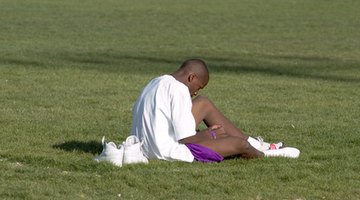Participation in sports is a way for people to exercise and enjoy their free time. For many people, sports activities are nearly their only form of regular exercise. However, the health benefits of sports may be mitigated by sports-related injuries. Because of the risks involved in sports, participants must be aware of the dangers. With reasonable caution and precautions, most people can enjoy both the pleasure of sports and the health benefits of exercise.
Benefits of Regular Exercise

"Diet and exercise" is one of the most common pieces of advice a family doctor will give in a normal day. This is the cure for excess weight, fatigue and a host of other minor problems that may become major health issues if not dealt with in a timely manner. For most people, regular exercise comes in the form of sports participation. This can be team sports, such as the softball team at work, or individual sports, such as jogging or riding the bicycle. Just as medicines can cure if used properly or kill if misused, the health benefits of sports exercise may be dwarfed by injuries or even sports-related death.
- "Diet and exercise" is one of the most common pieces of advice a family doctor will give in a normal day.
- Just as medicines can cure if used properly or kill if misused, the health benefits of sports exercise may be dwarfed by injuries or even sports-related death.
Risks of Sports Injuries

In 1998, baby boomers suffered more than 1 million sports-related injuries (with a cost of over £11 billion in medical expenses), with bicycling, basketball, running and baseball being the lead activities where these injuries occurred. In 2006, these numbers climbed to more than 500,000 injuries related to basketball alone. Running, bicycling, football and other sports injuries totalled more than 2 million cases. These numbers and the pain, medical and lost-work costs emphasise the importance of safety in sports.
- In 1998, baby boomers suffered more than 1 million sports-related injuries (with a cost of over £11 billion in medical expenses), with bicycling, basketball, running and baseball being the lead activities where these injuries occurred.
- Running, bicycling, football and other sports injuries totalled more than 2 million cases.
Risks for Children

In the U.S. alone, more than 3,500,000 sports-related injuries are reported each year for children 14 and younger. Nearly one-third of childhood injuries are related to sports activities, with strains and sprains being the most common. Death is rare, but most sports-related childhood deaths come from brain injuries. Bicycling, skating and skateboarding accidents account for nearly half of all childhood sports-related brain injuries. Many states and cities require children to wear protective headgear while participating in these activities, and many children (and their parents) ignore these requirements.
- In the U.S. alone, more than 3,500,000 sports-related injuries are reported each year for children 14 and younger.
- Nearly one-third of childhood injuries are related to sports activities, with strains and sprains being the most common.
Sports Safety

Every sport has rules for safe and healthy participation. These often include simple guidelines for stretching before beginning the activity or rules designed to prevent players from injuring each other and coaches to monitor the game. Many sports also have specialised safety equipment, such as special shoes for runners to reduce the risk of foot and leg damage or a rafting enthusiast's flotation vest and helmet. To receive sanction as a sporting event, most sporting organisations must present a set of safety guidelines and demonstrate how those guidelines will be implemented.
- Every sport has rules for safe and healthy participation.
- These often include simple guidelines for stretching before beginning the activity or rules designed to prevent players from injuring each other and coaches to monitor the game.
Sports Safety Tips

Most sports may be enjoyed safely with a few simple precautions. The first precaution is to be in physical condition to participate in the sport. This does not mean you must be in superb shape, but you must be at least minimally able to play at the level needed. If your running stamina is only 500 yards, don't attempt a marathon. Start with long walks and work your way up through jogging to shorter runs and then progress to longer runs. Stretch before starting any sport. This will improve circulation, loosen muscles and reduce the risk of muscle and joint injury. Drink water before, during and after your sport activity. Always use proper gear and safety equipment. Obey the rules of the game, both for good sportsmanship and for safety.
- Most sports may be enjoyed safely with a few simple precautions.
- If your running stamina is only 500 yards, don't attempt a marathon.
